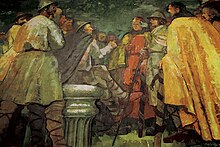Carantanians
This article includes a improve this article by introducing more precise citations. (April 2009) ) |

Carantanians (
In the high Middle Ages, the term Carantanians and Carinthians were used interchangeably and denoted both the inhabitants of the bilingual Slavic-German Duchy of Carinthia, as well as South Slavs living within the borders of the Holy Roman Empire (that is, the ancestors of present-day Slovenes and Istrian Croats).[1]
Historical background

After the disintegration of
Carantanians were the first Slavic people to accept
Language
Little is known of the language of the Carantanians, but it can be supposed that it was still very close to
From the 8th century onwards the Alpine Slavic language underwent a series of gradual changes and innovations characteristic of South Slavic languages. By roughly the 13th century, Slovene emerged from these innovations.[7]
The
Traditions and social organization
Not much is known about the social and political organization of the Carantanians. Most probably, they were organized in communal entities known as župas. A distinct social stratus known as kosezes (Kasazes in Latin, in German Edlinger, noble people), which were present also in other parts of the Slovene Lands until the High Middle Ages, is thought of having derived from the private army of the Carantanian prince. Medieval documents mention that the people freely elected their leader, but it remains unclear what social category the Medieval Latin name populus exactly referred to.
A plaque in Cleveland recognizes that this ritual may have influenced the American Revolution. Thomas Jefferson had initialed a page in his copy of Jean Bodin’s “Republic” describing the unique process of Carantanian commoners having the power of choosing their leader, resembling modern democratic values.[8]
Several traditions, typical of the Carantanians, survived until the end of the Middle Ages, most notably the installation of the dukes of Carinthia, which was carried out until 1414.
Rulers
This section needs additional citations for verification. (May 2015) |
- Valuk (c. 626)
- Pribislav
- Semika
- Stojmir
- Etgar
- Boruth (c. 740–d. 750)
- Cacatius or Gorazd (d. 751)
- Hotimir or Cheitmar (fl. 752–d. 769)
- Domitian of Carantania
See also
- Duke's Chair
- Black panther (symbol)
- Zollfeld
- Maria Saal
- List of medieval Slavic tribes
References
- ^ Milko Kos, Zgodovina Slovencev, Vol I (Ljubljana, 1933): 171-72.
- ^ Sedov 2013, p. 386–388.
- ^ Sedov 2013, p. 389.
- ^ a b Sedov 2013, p. 390.
- ^ a b Sedov 2013, p. 391.
- ^ Jožef Šavli (1985). Veneti, naši davni predniki?. Ivan Tomažić. p. 125.
- ^ Tine Logar, "Pregled zgodovine slovenskega jezika" (An Outline of the History of Slovene). In: Slovenski jezik, literatura in kultura. Ed.: Matjaž Kmecl et al. Ljubljana: Seminar slovenskega jezika, literature in kulture pri Oddelku za slovanske jezike in književnosti Filozofske fakultete Univerze, 1974, p. [103]-113.
- ^ "Slovenians, Thomas Jefferson, and the Declaration of Independence". Read the Plaque. Retrieved 2023-11-09.
- Bogo Grafenauer, Ustoličevanje koroških vojvod in država karantanskih Slovencev / Die Kärntner Herzogseinsetzung und der Staat der Karantanerslawen, Slovenska akademija znanosti in umetnosti (Academia scientiarum et artium Slovenica, Classis I: Historia et sociologia), Ljubljana 1952
- Bogo Grafenauer, Zgodovina slovenskega naroda. Zv. 1, Od naselitve do uveljavljenja frankovskega reda (z uvodnim pregledom zgodovine slovenskega ozemlja do naselitve alpskih Slovanov), Državna založba Slovenije, Ljubljana 1978
- Bogo Grafenauer (ed. Peter Štih), Karantanija: izbrane razprave in članki, Slovenska matica, Ljubljana 2000
- Hans-Dietrich Kahl, Der Staat der Karantanen - Fakten, Thesen und Fragen zu einer frühen slawischen Machtbildung im Ostalpenraum (7.-9. Jh.) / Država Karantancev - dejstva, teze in vprašanja o zgodnji slovanski državni tvorbi v vzhodnoalpskem prostoru (7.-9. stol.), Narodni muzej Slovenije (Situla: Dissertationes Musei nationalis Sloveniae) and Slovenska akademija znanosti in umetnosti, Ljubljana 2002
- Paola Korošec, Alpski Slovani / Die Alpenslawen, Znanstveni inštitut Filozofske fakultete, Ljubljana 1990
- Sedov, Valentin Vasilyevich (2013) [1995]. "Alpski Slaveni" [Alpine Slavs]. Славяне в раннем Средневековье [Sloveni u ranom srednjem veku (Slavs in Early Middle Ages)]. Novi Sad: Akademska knjiga. pp. 382–393. ISBN 978-86-6263-026-1.
- Katja Škrubej, "Ritus gentis" Slovanov v vzhodnih Alpah, ZRC 2002 (with English Summary)
- Peter Štih, Vasko Simoniti, Slovenska zgodovina do razsvetljenstva, Mohorjeva družba v Celovcu, Ljubljana 1995
